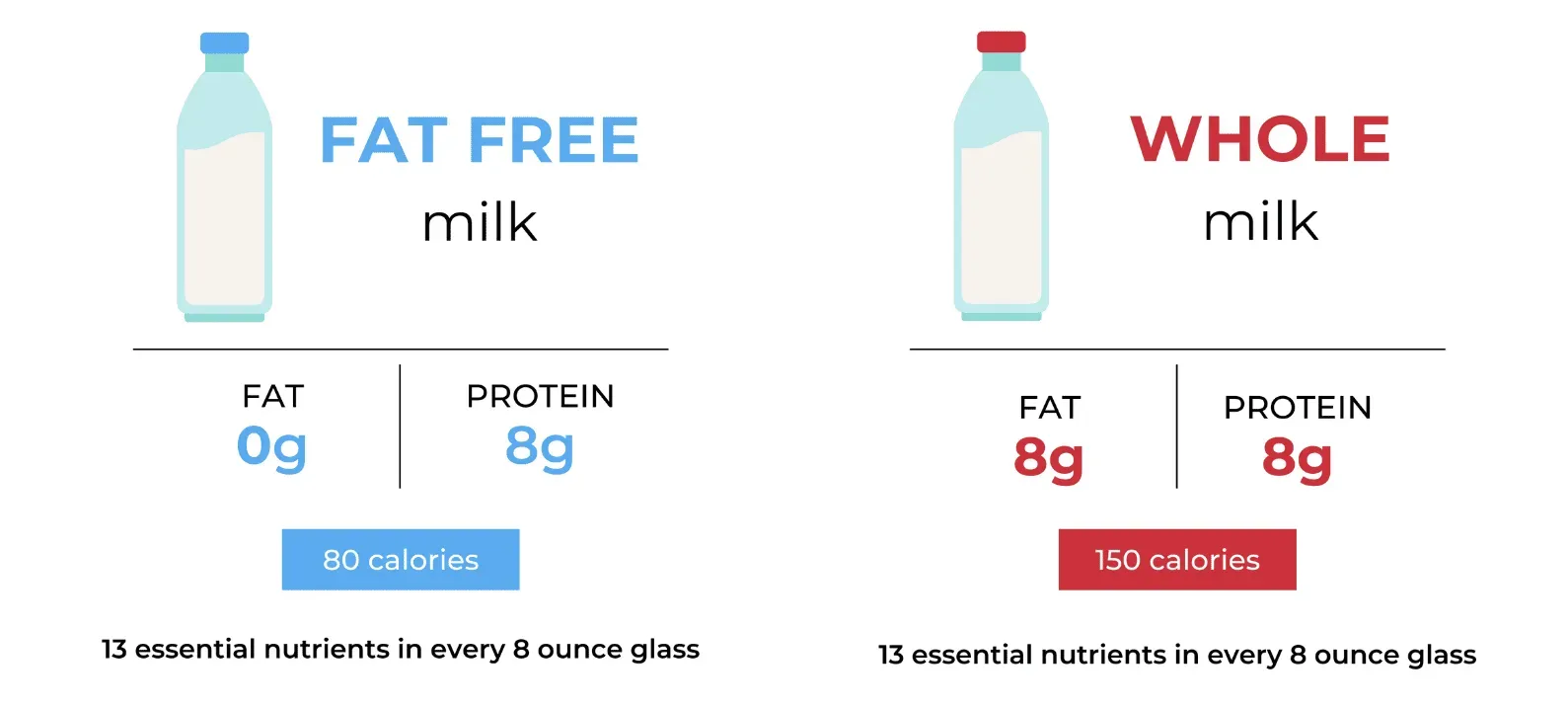Table of Contents
For years, the dairy aisle has been a battleground, or at least a place of mild confusion. On one side, the creamy, comforting presence of full fat milk. On the other, its leaner counterpart, low fat milk, often touted as the healthier option. The debate around full fat milk vs low fat milk isn't new, but the science, and public opinion, seem to keep shifting. Is sipping skim really the superior health move, or have we been too quick to demonize dietary fat? This isn't just about taste preference; it's about understanding what's actually in your glass and how it impacts your body. We'll cut through the noise, examining the nutritional profiles, the real science on fat intake, and who might benefit most from each type. By the end, you should have a clearer picture of whether full fat milk vs low fat milk fits into your diet.
Understanding Full Fat Milk vs Low Fat Milk: More Than Just Fat Content

Understanding Full Fat Milk vs Low Fat Milk: More Than Just Fat Content
What's the Real Difference Anyway?
let's get down to brass tacks about full fat milk vs low fat milk. When you grab a gallon, you see labels like "Whole Milk," "2% Reduced Fat," "1% Low Fat," and "Skim" or "Non-Fat." Whole milk, or full fat milk, typically contains around 3.25% milk fat by weight. That might not sound like a lot, but it's enough to give it that rich, creamy texture and distinct flavor people either love or avoid. Low fat milk, specifically 1% and 2%, have had some of that fat removed, landing around 1% or 2% fat content. Skim milk takes it even further, aiming for virtually zero fat, usually less than 0.5%. But thinking the only difference is the fat percentage misses a bigger picture. The fat content influences how the milk feels in your mouth, how certain vitamins (like A and D, which are fat-soluble) are absorbed, and even the overall nutrient density. It's not just a simple math problem of fat grams.
Nutritional Breakdown: Comparing Full Fat Milk vs Low Fat Milk Benefits

Nutritional Breakdown: Comparing Full Fat Milk vs Low Fat Milk Benefits
Beyond Just Calories: Fat-Soluble Vitamins and More
Alright, let's dig into the nitty-gritty of what's actually *in* the milk when we talk full fat milk vs low fat milk. Sure, the obvious difference is the fat content and, subsequently, the calories. Full fat milk packs more calories because fat is calorie-dense. But here's where it gets interesting: those fat molecules aren't just empty calories. They are crucial for absorbing certain vitamins. Think vitamins A, D, E, and K. These are fat-soluble vitamins. Without fat, your body struggles to utilize them effectively. So, while low fat or skim milk might be fortified with these vitamins, having the natural fat present in full fat milk can actually help your body absorb them better. It's like having the key (fat) to unlock the door (vitamin absorption).
Protein, Calcium, and the Rest of the Gang
Now, let's look at the other essential nutrients. When you strip away fat in low fat milk, you aren't necessarily stripping away the protein or calcium. Generally speaking, the protein content stays pretty consistent across different milk fat levels. You're getting roughly the same amount of muscle-building protein whether you choose whole or skim. Same goes for calcium, that bone-strengthening mineral milk is famous for. Riboflavin, vitamin B12, phosphorus – these guys are generally present in similar amounts too. So, if your main goal is hitting your protein or calcium targets from milk, the fat level matters less. The primary nutritional trade-off when choosing full fat milk vs low fat milk really centers on the calorie count and the presence of natural fats for absorbing those fat-soluble vitamins.
Nutrient (per cup) | Full Fat Milk (Whole) | Low Fat Milk (1%) |
|---|---|---|
Calories | ~150 | ~100 |
Total Fat | ~8g | ~2.5g |
Saturated Fat | ~5g | ~1.5g |
Protein | ~8g | ~8g |
Calcium | ~300mg | ~300mg |
Vitamin D | ~2.4mcg (often fortified) | ~2.4mcg (often fortified) |
Vitamin A | ~120mcg RAE (some natural, often fortified) | ~120mcg RAE (often fortified) |
Weight, Health, and the Full Fat vs Low Fat Milk Debate

Weight, Health, and the Full Fat vs Low Fat Milk Debate
Weight, Health, and the Full Fat vs Low Fat Milk Debate
Alright, let's tackle the big question that probably drives a lot of the confusion around full fat milk vs low fat milk: Does the extra fat make you fat or unhealthy? For years, the dietary dogma was pretty straightforward: fat was the enemy, especially saturated fat, and cutting it out was key to a healthy weight and heart. So, swapping whole milk for skim seemed like a no-brainer. But the science has gotten a lot more interesting lately. It turns out, things aren't quite so black and white. While full fat milk does have more calories thanks to the fat, that fat also makes it more satisfying. Think about it – a small glass of creamy whole milk might leave you feeling content, whereas you might guzzle a larger amount of watery skim to get the same feeling, potentially evening out the calorie count or even exceeding it.
Furthermore, the link between dietary fat, particularly from dairy, and negative health outcomes like heart disease isn't as clear-cut as once believed. Some studies comparing full fat milk vs low fat milk consumption have even suggested that people who consume full-fat dairy don't necessarily gain more weight and may even have a slightly lower risk of conditions like type 2 diabetes. It's a shift in perspective that challenges the low-fat-at-all-costs mentality that dominated nutritional advice for decades. The matrix of how different nutrients interact in food, and how our bodies process them, is far more complex than simple calorie or fat grams counts.
- Full fat milk is more calorie-dense due to higher fat.
- The fat in whole milk can increase satiety, potentially leading to less overall consumption.
- Recent research questions the direct link between full-fat dairy and weight gain or heart disease risk.
- Some studies suggest neutral or even potentially positive associations with full-fat dairy for certain health markers.
Choosing Your Milk: Who Needs Full Fat, Who Needs Low Fat?

Choosing Your Milk: Who Needs Full Fat, Who Needs Low Fat?
Considering Your Goals and Taste Buds
So, after wading through the nutritional details and the evolving science, how do you actually decide which carton to grab? It really boils down to individual needs, dietary goals, and, frankly, what you enjoy drinking. If you're someone who finds full fat milk more satisfying, a smaller serving might be enough, preventing you from overconsuming other things later. It offers that creamy mouthfeel that many people prefer, making it a more enjoyable part of their diet, which matters for consistency. For growing children, the extra calories and fat in whole milk can be beneficial for development. The naturally occurring fats also help with the absorption of those fat-soluble vitamins we talked about earlier. If your overall diet is relatively low in saturated fat from other sources and you're not strictly counting every single calorie, full fat milk can easily fit into a balanced eating pattern.
When Low Fat Might Be the Smarter Pick
On the flip side, low fat milk definitely has its place. If you are on a strict calorie budget, perhaps aiming for weight loss, the lower calorie count of 1% or skim milk is a simple way to save a few hundred calories over the course of a week, assuming milk is a regular part of your diet. For individuals with specific medical conditions where saturated fat intake needs to be tightly managed, choosing a lower-fat option might be a necessary dietary adjustment recommended by a healthcare professional. It provides the protein and calcium punch without the extra fat and calories. It's a trade-off – you lose some of the natural fat for vitamin absorption, but you gain significant calorie reduction.
- **Choose Full Fat If:** You prefer the taste/texture, seek higher calorie/fat intake (e.g., growing kids), prioritize absorption of fat-soluble vitamins, and your overall diet accommodates the extra fat/calories.
- **Choose Low Fat If:** You are closely managing calorie intake for weight loss, need to limit saturated fat for medical reasons, or simply prefer the lighter texture.
Making the Informed Choice for You
Ultimately, the choice between full fat milk vs low fat milk isn't a moral one, despite how some nutrition trends might make it feel. Neither is inherently "bad" or "good" for everyone. It's about context. Consider your overall dietary pattern – are you getting plenty of healthy fats elsewhere? Are you meeting your calorie and nutrient needs? Don't let outdated fear-mongering about fat dictate your decisions. Look at the whole picture of your diet and lifestyle. Maybe you use a splash of whole milk in your coffee and drink skim with cereal. That's fine too. The best milk is the one that helps you meet your nutritional needs and that you actually enjoy drinking, consistently, as part of a balanced diet.
Making Your Milk Choice: Full Fat vs Low Fat
So, where does that leave us in the full fat milk vs low fat milk showdown? The simple answer is, it's complicated, and often depends on your individual dietary needs and health goals. Full fat milk offers more calories and saturated fat, yes, but also delivers fat-soluble vitamins and a richer taste that might lead to less overall consumption. Low fat milk cuts calories and fat, which can be useful for some, but it doesn't magically make it a health elixir, and sometimes nutrients are lost or less bioavailable. There's no single villain or hero here. Consider your overall diet, calorie needs, and how milk fits into your bigger picture. Ultimately, the best milk is often the one you'll consistently consume as part of a balanced eating pattern, providing you get the nutrients you need from other sources too.
